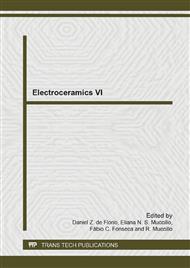p.238
p.243
p.248
p.257
p.263
p.268
p.274
p.283
p.288
Controlled Atmosphere Thermal Treatment for Pyrochlore Phase Elimination of PMN-PT/CFO Prepared by Spark Plasma Sintering
Abstract:
Multiferroics are interesting materials which present more than one ferroic property and have a great potential for practical applications [,,]. In addition, the coupling of magnetic and electric properties, the magnetoelectric effect (ME), offers news possibilities to applications [2,]. The magnetoelectric effect can be observed in single-phase materials like LuFe2O4, BiFeO3, etc. [1,] or in composites like PMN-PT/CFO, BaTiO3/CoFe2O4, etc. The ME composites have advantages over single-phase materials. They are easier to fabricate, less expensive, and have a wider range of working temperatures than single-phase materials []. However, some parameters that enhance the ME response need to be optimized. These parameters are the composition, the microstructure (grain size, grain orientation) and sintering parameters [6]. Thus, this work attempts to create a synthesis protocol to prepare the ME composite PMN-PT/CFO by Spark Plasma Sintering (SPS) keeping the average grain size as small as possible.
Info:
Periodical:
Pages:
274-279
Citation:
Online since:
July 2014
Price:
Сopyright:
© 2014 Trans Tech Publications Ltd. All Rights Reserved
Share:
Citation:


